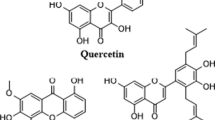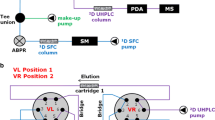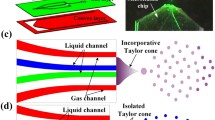Abstract
Over the past two decades, microfluidic-based separations have been used for the purification, isolation, and separation of biomolecules to overcome difficulties encountered by conventional chromatography-based methods including high cost, long processing times, sample volumes, and low separation efficiency. Cyclotides, or cyclic peptides used by some plant families as defense agents, have attracted the interest of scientists because of their biological activities varying from antimicrobial to anticancer properties. The separation process has a critical impact in terms of obtaining pure cyclotides for drug development strategies. Here, for the first time, a mimic of the high-performance liquid chromatography (HPLC) on microfluidic chip strategy was used to separate the cyclotides. In this regard, silica gel-C18 was synthesized and characterized by Fourier-transform infrared spectroscopy (FTIR) and proton nuclear magnetic resonance (1H-NMR) and then filled inside the microchannel to prepare an HPLC C18 column-like structure inside the microchannel. Cyclotide extract was obtained from Viola ignobilis by a low voltage electric field extraction method and characterized by HPLC and matrix-assisted laser desorption/ionization-time of flight (MALDI-TOF). The extract that contained vigno 1, 2, 3, 4, 5, and varv A cyclotides was added to the microchannel where distilled water was used as a mobile phase with 1 µL/min flow rate and then samples were collected in 2-min intervals until 10 min. Results show that cyclotides can be successfully separated from each other and collected from the microchannel at different periods of time. These findings demonstrate that the use of microfluidic channels has a high impact on the separation of cyclotides as a rapid, cost-effective, and simple method and the device can find widespread applications in drug discovery research.
Graphical Abstract






Similar content being viewed by others
References
Burman R, Yeshak MY, Larsson S, Craik DJ, Rosengren KJ, Göransson U. Distribution of circular proteins in plants: large-scale mapping of cyclotides in the Violaceae. Front Plant Sci. 2015;6:855. https://doi.org/10.3389/fpls.2015.00855.
de Veer SJ, Kan M-W, Craik DJ. Cyclotides: from structure to function. Chem Rev. 2019;119(24):12375–421. https://doi.org/10.1021/acs.chemrev.9b00402.
Daly NL, Rosengren KJ, Craik DJ. Discovery, structure and biological activities of cyclotides. Adv Drug Deliv Rev. 2009;61(11):918–30. https://doi.org/10.1016/j.addr.2009.05.003.
Dayani L, Dinani MS, Aliomrani M, Hashempour H, Varshosaz J, Taheri A (2022) Immunomodulatory effects of cyclotides isolated from Viola odorata in an experimental autoimmune encephalomyelitis animal model of multiple sclerosis. Mult Scler Relat Disord: 103958. https://doi.org/10.1016/j.msard.2022.103958.
Henriques ST, Craik DJ. Cyclotides as templates in drug design. Drug Discov Today. 2010;15(1–2):57–64. https://doi.org/10.1016/j.drudis.2009.10.007.
Craik DJ, Daly NL, Mulvenna J, Plan MR, Trabi M. Discovery, structure and biological activities of the cyclotides. Curr Prot Pept Sci. 2004;5(5):297–315. https://doi.org/10.2174/1389203043379512.
Hashempour H, Koehbach J, Daly NL, Ghassempour A, Gruber CW. Characterizing circular peptides in mixtures: sequence fragment assembly of cyclotides from a violet plant by MALDI-TOF/TOF mass spectrometry. Amino Acids. 2013;44(2):581–95. https://doi.org/10.1007/s00726-012-1376-x.
Hashempour H, Ghassempour A, Daly NL, Spengler B, Rompp A. Analysis of cyclotides in Viola ignobilis by nano liquid chromatography Fourier transform mass spectrometry. Protein Pept Lett. 2011;18(7):747–52. https://doi.org/10.2174/092986611795446030.
Bayareh M. An updated review on particle separation in passive microfluidic devices. Chem Eng Process-Process Intensif. 2020;153:107984. https://doi.org/10.1016/j.cep.2020.107984.
Gao Y, Wu M, Lin Y, Xu J. Acoustic microfluidic separation techniques and bioapplications: a review. Micromachines. 2020;11(10):921. https://doi.org/10.3390/mi11100921.
Al-Faqheri W, Thio THG, Qasaimeh MA, Dietzel A, Madou M, Aa Al-Halhouli. Particle/cell separation on microfluidic platforms based on centrifugation effect: a review. Microfluid Nanofluidics. 2017;21(6):1–23. https://doi.org/10.1007/s10404-017-1933-4.
McGrath J, Jimenez M, Bridle H. Deterministic lateral displacement for particle separation: a review. Lab Chip. 2014;14(21):4139–58. https://doi.org/10.1039/C4LC00939H.
Jeon H, Kim S, Lim G. Electrical force-based continuous cell lysis and sample separation techniques for development of integrated microfluidic cell analysis system: a review. Microelectron Eng. 2018;198:55–72. https://doi.org/10.1016/j.mee.2018.06.010.
Wu Z, Hjort K. Microfluidic hydrodynamic cell separation: a review. Micro Nanosyst. 2009;1(3):181–92. https://doi.org/10.2174/1876402910901030181.
Yang R-J, Hou H-H, Wang Y-N, Fu L-M. Micro-magnetofluidics in microfluidic systems: a review. Sens Actuators B: Chem. 2016;224:1–15. https://doi.org/10.1016/j.snb.2015.10.053.
De Jong J, Lammertink RG, Wessling M. Membranes and microfluidics: a review. Lab Chip. 2006;6(9):1125–39. https://doi.org/10.1039/B603275C.
Chen X, Shen J. Review of membranes in microfluidics. J Chem Technol Biotechnol. 2017;92(2):271–82. https://doi.org/10.1002/jctb.5105.
Piotrowska M, Ciura K, Zalewska M, Dawid M, Correia B, Sawicka P, et al. Capillary zone electrophoresis of bacterial extracellular vesicles: a proof of concept. J Chromatogr A. 2020;1621:461047. https://doi.org/10.1016/j.chroma.2020.461047.
Ramachandran A, Huyke DA, Sharma E, Sahoo MK, Huang C, Banaei N, et al. Electric field-driven microfluidics for rapid CRISPR-based diagnostics and its application to detection of SARS-CoV-2. Proc Natl Acad Sci. 2020;117(47):29518–25. https://doi.org/10.1073/pnas.2010254117.
Saar KL, Müller T, Charmet J, Challa PK, Knowles TP. Enhancing the resolution of micro free flow electrophoresis through spatially controlled sample injection. Anal Chem. 2018;90(15):8998–9005. https://doi.org/10.1021/acs.analchem.8b01205.
Kašička V. Recent developments in capillary and microchip electroseparations of peptides (2019–mid 2021). Electrophoresis. 2022;43(1–2):82–108. https://doi.org/10.1002/elps.202100243.
Sun W-W, Dai R-J, Li Y-R, Dai G-X, Liu X-J, Li B, et al. Separation of proteins and DNA by microstructure-changed microfuidic free flow electrophoresis chips. Acta Astronaut. 2020;166:573–8. https://doi.org/10.1016/j.actaastro.2018.11.016.
Lu X, Liu C, Hu G, Xuan X. Particle manipulations in non-Newtonian microfluidics: a review. J Colloid Interface Sci. 2017;500:182–201. https://doi.org/10.1016/j.jcis.2017.04.019.
Dalili A, Samiei E, Hoorfar M. A review of sorting, separation and isolation of cells and microbeads for biomedical applications: microfluidic approaches. Analyst. 2019;144(1):87–113. https://doi.org/10.1039/C8AN01061G.
Bhagat AAS, Bow H, Hou HW, Tan SJ, Han J, Lim CT. Microfluidics for cell separation. Med Biol Eng Comput. 2010;48(10):999–1014. https://doi.org/10.1007/s11517-010-0611-4.
Giordano BC, Burgi DS, Hart SJ, Terray A. On-line sample pre-concentration in microfluidic devices: a review. Anal Chim Acta. 2012;718:11–24. https://doi.org/10.1016/j.aca.2011.12.050.
Tetala KK, Vijayalakshmi M. A review on recent developments for biomolecule separation at analytical scale using microfluidic devices. Anal Chim Acta. 2016;906:7–21. https://doi.org/10.1016/j.aca.2015.11.037.
Karle M, Vashist SK, Zengerle R, von Stetten F. Microfluidic solutions enabling continuous processing and monitoring of biological samples: a review. Anal Chim Acta. 2016;929:1–22. https://doi.org/10.1016/j.aca.2016.04.055.
Antfolk M, Laurell T. Continuous flow microfluidic separation and processing of rare cells and bioparticles found in blood—a review. Anal Chim Acta. 2017;965:9–35. https://doi.org/10.1016/j.aca.2017.02.017.
Sonker M, Sahore V, Woolley AT. Recent advances in microfluidic sample preparation and separation techniques for molecular biomarker analysis: a critical review. Anal Chim Acta. 2017;986:1–11. https://doi.org/10.1016/j.aca.2017.07.043.
Sajeesh P, Sen AK. Particle separation and sorting in microfluidic devices: a review. Microfluid Nanofluidics. 2014;17(1):1–52. https://doi.org/10.1007/s10404-013-1291-9.
Santana H, Silva J, Aghel B, Ortega-Casanova J. Review on microfluidic device applications for fluids separation and water treatment processes. SN Appl Sci. 2020;2(3):1–19. https://doi.org/10.1007/s42452-020-2176-7.
Viefhues M, Eichhorn R, Fredrich E, Regtmeier J, Anselmetti D. Continuous and reversible mixing or demixing of nanoparticles by dielectrophoresis. Lab Chip. 2012;12(3):485–94. https://doi.org/10.1039/C1LC20610A.
Dawod M, Arvin NE, Kennedy RT. Recent advances in protein analysis by capillary and microchip electrophoresis. Analyst. 2017;142(11):1847–66. https://doi.org/10.1039/c7an00198c.
Sun L, Zhu G, Yan X, Champion MM, Dovichi NJ. Capillary zone electrophoresis for analysis of complex proteomes using an electrokinetically pumped sheath flow nanospray interface. Proteomics. 2014;14(4–5):622–8. https://doi.org/10.1002/pmic.201300295.
Berlanda SF, Breitfeld M, Dietsche CL, Dittrich PS. Recent advances in microfluidic technology for bioanalysis and diagnostics. Anal Chem. 2021;93(1):311–31. https://doi.org/10.1021/acs.analchem.0c04366.
Avci H. Polimerler: Özellikleri Ve Uygulamalari, Publisher: ESOGU Yayinevi. 2021.
Ghorbanpoor H, Dizaji AN, Akcakoca I, Blair EO, Ozturk Y, Hoskisson P, et al. A fully integrated rapid on-chip antibiotic susceptibility test—a case study for Mycobacterium smegmatis. Sens Actuators A: Phys. 2022;339:113515. https://doi.org/10.1016/j.sna.2022.113515.
Didarian R, Ebrahimi A, Ghorbanpoor H, Bagheroghli H, Doğan Güzel F, Farhadpour M, et al. On chip microfluidic separation of cyclotides. Turk J Chem. 2023;47(1):253–62. https://doi.org/10.55730/1300-0527.3534.
Didarian R, Ebrahimi A, Ghorbanpoor H, Dizaji A, Hashempour H, Guzel F et al (2021) Investigation of polar and nonpolar cyclotides separation from violet extract through microfluidic chip. 8 International Fiber and Polymer Research Symposium; 18-19 June 2021; Eskişehir, Turkey2021. p 238-41.
Shin SR, Zhang YS, Kim D-J, Manbohi A, Avci H, Silvestri A, et al. Aptamer-based microfluidic electrochemical biosensor for monitoring cell-secreted trace cardiac biomarkers. Anal Chem. 2016;88(20):10019–27. https://doi.org/10.1021/acs.analchem.6b02028.
Avci H, Doğan Güel F, Erol S, Akpek A. Recent advances in organ-on-a-chip technologies and future challenges: a review. Turk J Chem. 2018;42(3):587–610. https://doi.org/10.3906/kim-1611-35.
Özel C, Koç Y, Topal AE, Ebrahimi A, Şengel T, Ghorbanpoor H et al (2021) Investigation of 3D culture of human adipose tissue-derived mesenchymal stem cells in a microfluidic platform. Eskişehir Tech Univ J Sci Technol A-Appl Sci Eng 22(8th ULPAS-Special Issue 2021):85–97. https://doi.org/10.18038/estubtda.983881.
Özel C, Koç Y, Topal AE, Ebrahimi A, Şengel T, Ghorbanpoor H et al. Investigation of mesenchymal cells in the microfluidic cell culture device. 8th International Fiber and Polymer Research Symposium; 18–19 June 2021; ESkişehir, Turkey. 2021. p. 53–4. https://doi.org/10.5281/zenodo.5764365
Mohammadigharebagh R, Tomsuk Ö, Ghorbanpoor H, Ebrahimi A, Abdullayeva N, Gasimzade N et al. Adsorption challenge in the PDMS-based microfluidic systems for drug screening application. 11th International Fiber and Polymer Research Symposium; 4–5 November; Gebze, Turkey. 2022. p. 222–6.
Tetala KK, Swarts JW, Chen B, Janssen AE, Van Beek TA. A three-phase microfluidic chip for rapid sample clean-up of alkaloids from plant extracts. Lab Chip. 2009;9(14):2085–92. https://doi.org/10.1039/B822106E.
Ebrahimi A. Patojenik bakterilerin tanisi için nanoesasli sensor platformlari. Hacettepe University, Fen Bilimleri Enstitüsü; 2017. p. 1–131. https://openaccess.hacettepe.edu.tr/xmlui/handle/11655/3992
Pourjavadi A, Ebrahimi A, Barzegar S. Preparation and evaluation of bioactive and compatible starch based superabsorbent for oral drug delivery systems. J Drug Deliv Sci Technol. 2013;23(5):511–7. https://doi.org/10.1016/S1773-2247(13)50074-8.
Moharrami S, Hashempour H. Comparative study of low-voltage electric field-induced, ultrasound-assisted and maceration extraction of phenolic acids. J Pharm Biomed Anal. 2021;202:114149. https://doi.org/10.1016/j.jpba.2021.114149.
Sanagi MM, Naim AA, Hussain A, Dzakaria N. Preparation and application of octadecylsilyl-silica adsorbents for chemical analysis. Malaysian J Anal Sci. 2001;7(2):337–43.
Grain L. Isolation of oxytocic peptides from Oldenlandia affinis by solvent extraction of tetraphenylborate complexes and chromatography on sephadex LH-20. Lloydia. 1973;36(2):207–8.
Gran L. Oxytocic principles of Oldenlandia affinis. Lloydia. 1973;36(2):174–8.
Gran L. On the effect of a polypeptide isolated from “Kalata-Kalata” (Oldenlandia affinis DC) on the oestrogen dominated uterus. Acta Pharmacol Toxicol. 1973;33(5–6):400–8.
Saether O, Craik DJ, Campbell ID, Sletten K, Juul J, Norman DG. Elucidation of the primary and three-dimensional structure of the uterotonic polypeptide kalata B1. Biochemistry. 1995;34(13):4147–58.
Göransson U, Luijendijk T, Johansson S, Bohlin L, Claeson P. Seven novel macrocyclic polypeptides from Viola arvensis. J Nat Prod. 1999;62(2):283–6. https://doi.org/10.1021/np9803878.
Hallock YF, Sowder RC, Pannell LK, Hughes CB, Johnson DG, Gulakowski R, et al. Cycloviolins A−D, anti-HIV macrocyclic peptides from Leonia cymosa1. J Org Chem. 2000;65(1):124–8. https://doi.org/10.1021/jo990952r.
Gruber CW, Elliott AG, Ireland DC, Delprete PG, Dessein S, Göransson U, et al. Distribution and evolution of circular miniproteins in flowering plants. Plant Cell. 2008;20(9):2471–83. https://doi.org/10.1105/tpc.108.062331.
Esmaeili MA, Abagheri-Mahabadi N, Hashempour H, Farhadpour M, Gruber CW, Ghassempour A. Viola plant cyclotide vigno 5 induces mitochondria-mediated apoptosis via cytochrome C release and caspases activation in cervical cancer cells. Fitoterapia. 2016;109:162–8. https://doi.org/10.1016/j.fitote.2015.12.021.
Acknowledgements
Thanks to the Turkish Scientific and Technological Council (TÜBİTAK) for their support under the grant numbers of 119N608, 20AG003 and 20AG031. Thanks to the Iranian Ministry of Science Research and Technology (MSRT), University of Tabriz, and Azarbaijan Shahid Madani University for their support under the grant number of IRTU-99-24-800. Thanks to the Scientific Research Projects (BAP- the priority areas project (ONAP) for their support under the grant number of TOA-2022-2307 of Eskisehir Osmangazi University.
Funding
- Turkish Scientific and Technological Council (TÜBİTAK) under the grant number of 119N608, and TUBİTAK 1004- Regenerative and Restorative Medicine Research and Applications) under the grant numbers of 20AG003 and 20AG031, and Scientific Research Projects (BAP- the priority areas project (ONAP) under the grant number of TOA-2022-2307 of Eskisehir Osmangazi University.
- Iranian Ministry of Science Research and Technology (MSRT) under the grant number of IRTU-99-24-800.
Author information
Authors and Affiliations
Contributions
AE: investigation, conceptualization, methodology, formal analysis, writing original draft — review and editing. RD: formal analysis, data curation, writing — original draft. HG: software, writing original draft — review and editing. FDG: project administration, conceptualization, funding acquisition, writing — review and editing. HH: design the project, project administration, methodology, formal analysis, writing — review and editing. HA: design the project, supervision, conceptualization, funding acquisition, project administration, writing — review and editing.
Corresponding author
Ethics declarations
Conflict of interest
The authors declare no competing interests.
Additional information
Publisher's Note
Springer Nature remains neutral with regard to jurisdictional claims in published maps and institutional affiliations.
Supplementary Information
Below is the link to the electronic supplementary material.
Rights and permissions
Springer Nature or its licensor (e.g. a society or other partner) holds exclusive rights to this article under a publishing agreement with the author(s) or other rightsholder(s); author self-archiving of the accepted manuscript version of this article is solely governed by the terms of such publishing agreement and applicable law.
About this article
Cite this article
Ebrahimi, A., Didarian, R., Ghorbanpoor, H. et al. High-throughput microfluidic chip with silica gel‐C18 channels for cyclotide separation. Anal Bioanal Chem 415, 6873–6883 (2023). https://doi.org/10.1007/s00216-023-04966-3
Received:
Revised:
Accepted:
Published:
Issue Date:
DOI: https://doi.org/10.1007/s00216-023-04966-3




